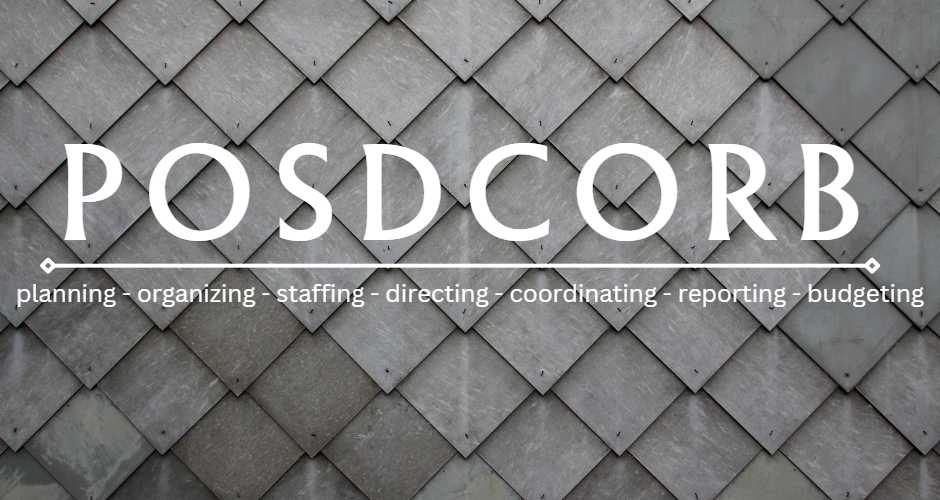Maintaining Management with “POSDCORB”
Originally drafted to organize the federal government’s executive branch, this theory has been given the acronym POSDCORB and highlights things such as an even division of work, chain of command, and stability.
The acronym stands for planning, organizing, staffing, directing, coordinating, reporting, and budgeting.
These reflect the various areas of management that need to be maintained throughout the life of an organization. These responsibilities are placed on the shoulders of chief executives, and they reflect what those in authority should be doing with their time. Executives must remember that they contribute to the overall success of the organization by directing other people, not by accomplishing the tasks themselves.

Let’s take a closer look…
Planning is the first step in accomplishing a goal. Before things can begin to move, the broad outline of the issue needs to be defined. What is the end goal? What kind of things will fall within this plan, and what is outside of the scope of work?
Organizing must come as a direct result of the planning process. Each portion of work must be split apart and subdivided into digestible pieces. This element thinks about the individual teams that have been built and critically evaluates if the division lines are currently the most effective groups to accomplish the task.
Staffing a project is the only way to ensure that an executive does not waste time with the actual work of the project. This element includes hiring and training staff that are committed to your plan. This does not mean that the executive must act as a hiring manager, but rather must oversee the process. In addition to obtaining qualified staff, it is the executive’s responsibility to make sure that conditions within the company are favorable for work. This will harken back to the previous task of organizing work so that no individual is overloaded.
Directing the decisions and giving direction to employees helps keep everyone on the same track. Reminding staff of the big picture plans (established in the first principle mentioned here) will help keep all work directed together and avoids staff members working against the flow. This means planning for regular team meetings and individual performance appraisals to ensure that everyone understands their objectives.
Coordinating all the moving parts into a clear chain of command acknowledges that each manager only has a certain amount of time in which to manage people. This chain of command must take into consideration a person’s span of control or the number of people they can successfully manage at a given time. It is also important to consider that each person within your organization should answer to only one manager to avoid frustration and confusion.
Reporting to those who need to know is an important element of management. The executive should be regularly informed about what is happening down the chain of command. At the same time, it is important for those at the top to regularly communicate with everyone else regarding the overall health of the company in order to boost morale and encourage staff members’ commitment to the big-picture goals. Everyone wants to feel like they have contributed to the overall success and will strive to work harder when they receive regular updates from those they work for.
Budgeting may not be the most exciting element of an executive’s job, but at the end of the day, a company needs to make money if it is going to stay open. Building and adhering to a budget will help everyone involved understand where money will be allocated and will help them as they work to complete their jobs. The success of a project hinges on a well-maintained budget.

These elements together create the ultimate job description for successful chief executives and can help direct the success of everyone involved. Rather than getting caught up in little tasks that need accomplishing – even if they only take a minute, taking a step back to create a framework for the entire company will help far more than getting little things done.
I’m not necessarily a Facebook fan, but Mark Zuckerberg had at least this right: “The question I ask myself like almost every day is, ‘Am I doing the most important thing I could be doing?’… Unless I feel like I’m working on the most important problem that I can help with, then I’m not going to feel good about how I’m spending my time. And that’s what this company is.”
Just because you know how to do a task better than someone else does not mean that doing it is the most productive thing you can do for your organization. By focusing on the elements of POSDCORB, your time will be better utilized and even if the small jobs are not done perfectly, your company will benefit.
